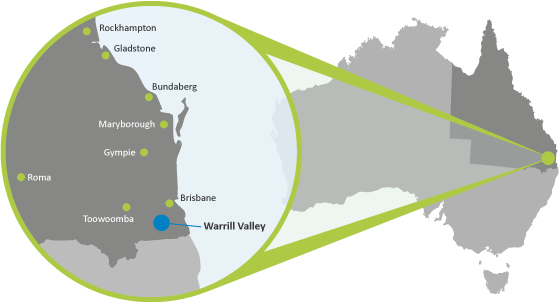Past review
The Warrill Valley water supply scheme is located near the town of Aratula.
The Warrill Valley water supply scheme provides water for the irrigation of about 8,000ha of farms as well as for urban and industrial users. It has 396 bulk customers of which 387 are irrigators holding 20,485 ML of medium priority allocation which is used for fodder crops, grain and horticulture.
The scheme was establish in 1961 following the construction of Moogerah Dam, a mass concrete double curvature dam which can hold up to 83,700 ML.Seqwater owns and operates the infrastructure in the scheme under the authority of the Interim Resource Operations Licence for the Warrill Valley water supply scheme.

The QCA has released its final recommended prices for the Warril Valley scheme for 2013-17. The Minister accepted the QCA’s recommendations.
Warrill Valley water charges
| 2013-14 | 2014-15 | 2015-16 | 2016-17 | |
|---|---|---|---|---|
| Fixed ($/ML WAE) | 21.91 | 22.46 | 23.02 | 23.59 |
| Variable ($/ML Use) | 7.31 | 7.50 | 7.68 | 7.88 |
In the Warrill Valley water supply scheme, cost-reflective volumetric charges are lower when compared to 2012-13.
To maintain revenues, the balance not recouped by volumetric charges is recovered by fixed charges which are higher than current levels.
As current revenues are below cost-reflective revenues, the QCA recommends price paths where fixed charges increase annually by $2 per ML (plus inflation) until cost-reflective levels are reached.
Volumetric charges are increased at inflation over the balance of the regulatory period.
This Seqwater water scheme review forms part of the review that the QCA undertook in 2012-13 for the Queensland Government: the Seqwater Irrigation Price Review 2013–17.
You can read more about the pricing review on our project home page. You can also view the submissions for the water schemes that we received, the consultants’ reports and issues arising from face-to-face consultation with stakeholders.
We recommended a new irrigation price path, to apply from July 2013 to June 2017 – with prices moving in a direction that better reflect costs.
- Key to the findings were the recovery of Seqwater’s costs and the smoothing of future price increases.
- All Seqwater schemes will now have two-part tariffs consisting of a fixed (Part A) price per megalitre (ML) of nominal water allocation and a usage (Part B) price per ML of water use.
- For the majority of schemes, our recommended prices result in increases to fixed prices and reductions in usage prices.